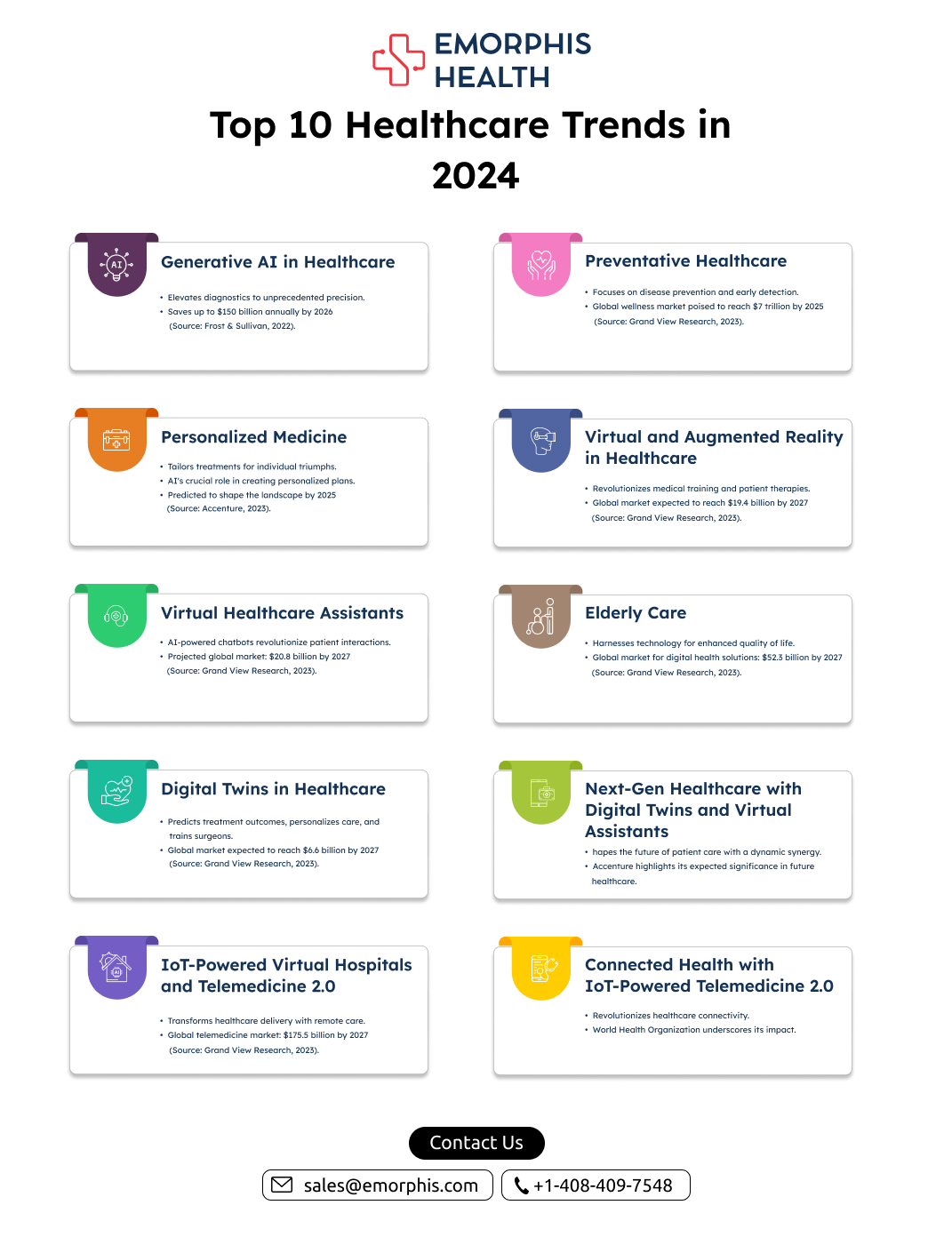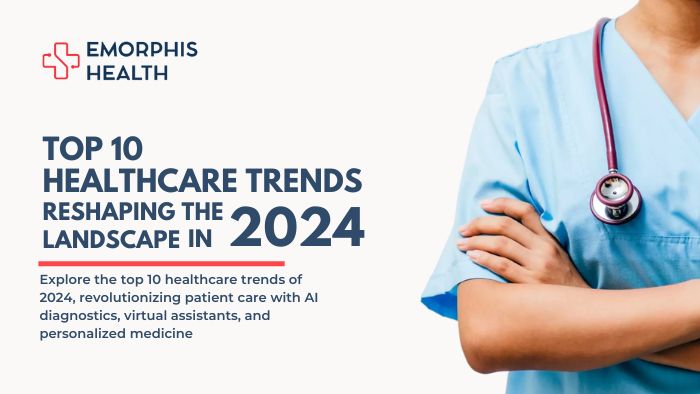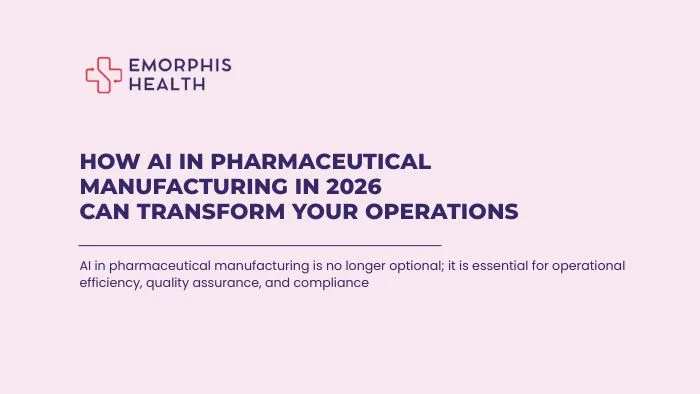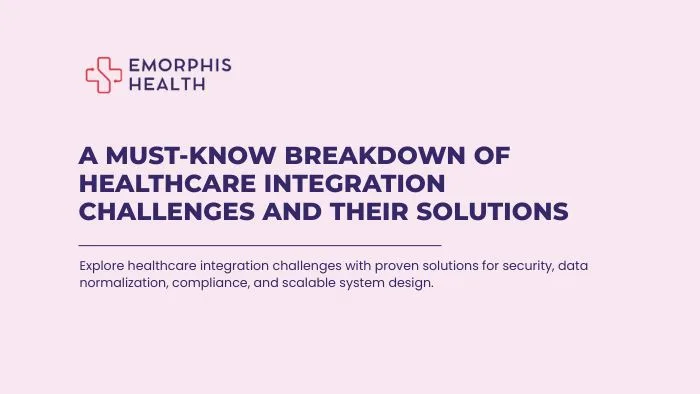Introduction
See Contents
- 1 Introduction
- 2 1. Generative AI In Healthcare
- 3 2. Personalized Medicine
- 4 3. Virtual Healthcare Assistants
- 5 4. Digital Twins in Healthcare
- 6 5. IoT-Powered Virtual Hospitals and Telemedicine 2.0
- 7 6. Preventative Healthcare
- 8 7. Virtual and Augmented Reality in Healthcare
- 9 8. Elderly Care
- 10 9. Next-Gen Healthcare with Digital Twins and Virtual Assistants
- 11 10. Connected Health with IoT-Powered Telemedicine 2.0
- 12 Conclusion
In the dynamic world of healthcare, the year 2024 is poised to witness a paradigm shift marked by transformative healthcare trends that go beyond mere technological advancements. These healthcare trends promise to redefine patient care, diagnostics, and also, the very fabric of the healthcare experience.
Let’s delve into the top 10 healthcare trends that are leading this charge into a new era.
1. Generative AI In Healthcare
Elevating Diagnostics to Unprecedented Precision
Generative AI in healthcare is a rapidly evolving field, encompassing the use of AI to generate realistic data, such as synthetic medical images, to train algorithms and accelerate research. This innovative technology not only creates synthetic data but also plays a pivotal role in transforming diagnostics. It brings about a level of precision that was once unimaginable. Moreover, healthcare professionals, armed with the capability to analyze vast datasets, are now empowered to achieve early detection and more accurate diagnosis of medical conditions.
As a matter of fact, studies suggest that the implementation of generative AI could lead to substantial cost savings, potentially saving the healthcare industry up to $150 billion annually by 2026 (Source: Frost & Sullivan, 2022). This underscores the significant impact of generative AI as one of the key healthcare trends, not just in enhancing diagnostics but also in contributing to financial efficiency within the industry.
2. Personalized Medicine
Tailoring Treatments for Individual Triumphs
Personalized medicine, a revolutionary trend in healthcare, involves tailoring treatments to individual patients, transforming the traditional approach to medical care. The advent of this era of healthcare trends brings forth a new methodology where treatment plans are meticulously crafted to align with the unique characteristics of each patient. AI is a crucial player in this transformation, analyzing vast amounts of data to create personalized plans that lead to significantly improved outcomes.
In fact, 79% of healthcare executives predict that AI will play a substantial role in shaping the landscape of personalized care by 2025, highlighting its pivotal position in the future of healthcare (Source: Accenture, 2023). Moreover, the shift towards personalized medicine is not only enhancing treatment effectiveness but is also proving to be a key driver in improving overall patient outcomes. This underscores the significance of personalized medicine as one of the leading healthcare trends, emphasizing the potential for better, more individualized healthcare experiences.
3. Virtual Healthcare Assistants
A Revolution in Patient Interaction
Virtual healthcare assistants, the AI-powered chatbots, are spearheading a transformative shift in the patient experience within the realm of healthcare. Virtual healthcare assistants, equipped to answer questions, schedule appointments, and provide basic medical advice, effectively alleviate administrative burdens on healthcare providers. This pivotal role is reflected in their projected global market, expected to reach a staggering $20.8 billion by 2027 (Source: Grand View Research, 2023). As these virtual assistants become increasingly one of the healthcare trends it is also getting integrated into the practices of healthcare providers. Their impact is evident in the enhancement of patient engagement and the overall enrichment of the healthcare experience. The 2023 AI revolution will surely make an impact and the convenience and efficiency offered by virtual healthcare assistants will help position them as integral components in the ever-evolving landscape of healthcare trends.
4. Digital Twins in Healthcare
Bridging Data Analytics and Patient Care
Digital Twins in Healthcare epitomize a cutting-edge trend, utilizing virtual models of organs and patients to predict treatment outcomes, personalize care, and train surgeons. The potential of these digital replicas is vast, as evidenced by the projected growth of the global digital twin market in healthcare, expected to reach $6.6 billion by 2027 (Source: Grand View Research, 2023). This integration of digital twin technology is not merely a technological advancement but a seamless bridge between data analytics and patient care, moreover going to be one of the healthcare trends.
Healthcare organizations that embrace digital twins are experiencing notable improvements in treatment outcomes, cost savings, and gaining a more holistic understanding of patient needs. The adoption of healthcare trends like digital twins is reshaping the healthcare landscape by offering a dynamic approach to patient care, training, and overall healthcare system efficiency.
5. IoT-Powered Virtual Hospitals and Telemedicine 2.0
Transforming Patient Services
IoT-Powered Virtual Hospitals and Telemedicine 2.0 are spearheading a revolution in healthcare delivery, ushering in an era where patients can receive care remotely through technologies like video conferencing. The transformative potential of telemedicine is heightened by the infusion of IoT devices and sensors, marking the advent of Telemedicine 2.0. This healthcare trends evolution not only expands virtual hospital implementations but fundamentally reshapes patient services.
The global telemedicine market is expected to soar to $175.5 billion by 2027 (Source: Grand View Research, 2023). By examining usage statistics and listening to patient feedback, we gain valuable insights into the transformative impact of this integration on healthcare accessibility and quality. The fusion of IoT and telemedicine app development solutions stands as a testament to the power of innovation in enhancing the overall healthcare experience, providing more comprehensive monitoring and treatment options for patients globally.
6. Preventative Healthcare
Curbing Chronic Illnesses and Enhancing Well-being
Preventative Healthcare, centered on disease prevention and early detection, stands as a powerful force capable of saving lives and curbing healthcare costs. This proactive approach is gaining prominence as wearable devices and other technologies empower individuals to take control of their health. The global wellness market is on track to achieve an impressive $7 trillion by 2025 (Source: Grand View Research, 2023), underscoring the growing acknowledgment of the importance of preventative healthcare. As these programs gain traction, their potential to reduce the prevalence of chronic illnesses becomes evident.
By focusing on proactive measures, the healthcare trends of preventative healthcare not only address health issues at their roots but also contribute significantly to substantial cost savings in the long run. The emphasis on prevention in healthcare represents transformative healthcare trends that not only enhance individual well-being but also have far-reaching implications for the overall sustainability of healthcare systems globally.
7. Virtual and Augmented Reality in Healthcare
Immersive Applications in Training and Therapy
Virtual and Augmented Reality (VR and AR) in healthcare are catalysts for a transformative shift in the healthcare landscape, providing immersive experiences for pain management, surgical training, and rehabilitation. Projections anticipate impressive growth, with the global market for VR and AR in healthcare expected to reach $19.4 billion by 2027 (Source: Grand View Research, 2023). This is becoming one of the prominent healthcare trends whereas immersive technology is not limited to one specific application; instead, it is revolutionizing both medical training and patient therapies.
The widespread adoption of VR and AR is not only enhancing the skills of healthcare professionals but also yielding tangible improvements in patient outcomes and satisfaction rates, thus becoming one of the healthcare trends. As we observe the increasing integration of these technologies. It also becomes evident that the impact of VR and AR in healthcare goes beyond mere healthcare innovation and is at the top of all healthcare trends. It fundamentally reshapes how healthcare professionals are trained and moreover how patients experience and engage with medical treatments.
8. Elderly Care
Harnessing Technology for Enhanced Quality of Life
Elderly Care is undergoing a transformative change with the crucial support of technology. Digital health solutions tailored for the elderly are proving instrumental in helping them maintain independence and also manage chronic conditions effectively. In fact, projections indicate an anticipated impressive growth, with the global market for these digital health solutions expected to reach $52.3 billion by 2027 (Source: Grand View Research, 2023).
This pivotal role played by technology extends beyond the financial realm; it’s fundamentally enhancing the quality of life for the elderly. The integration of technology, spanning from remote health monitoring to the development of assistive devices, is fostering independence and contributing to an overall improvement in the well-being of the elderly population. In this digital age, healthcare trends and technology are not just a tool but a companion in ensuring a more fulfilling and independent lifestyle for the elderly.
9. Next-Gen Healthcare with Digital Twins and Virtual Assistants
Shaping the Future of Patient Care
Next-Gen Healthcare, marked by the dynamic synergy of Digital Twins and Virtual Assistants, represents a significant leap forward in personalized care and enhanced patient engagement. This innovative combination offers a powerful alliance, paving the way for a future where healthcare delivery is not only efficient but also highly individualized. Accenture highlighted the expected significance of this approach in future healthcare, underscoring its importance.
The convergence of digital twins and virtual assistants is not merely a technological integration but a transformative force shaping the next generation of healthcare. By examining current integration trends and showcasing examples of successful outcomes, we catch a glimpse of a healthcare future that prioritizes efficiency, personalization, and an enriched patient experience. This healthcare trends approach stands at the forefront of the evolving healthcare landscape, promising a more tailored and patient-centric model for the years to come.
10. Connected Health with IoT-Powered Telemedicine 2.0
Revolutionizing Healthcare Connectivity
Connected Health, driven by the fusion of IoT and Telemedicine 2.0, is at the forefront of a revolutionary transformation in healthcare. IoT devices, integral to this shift, are playing a pivotal role by enabling real-time monitoring of vital signs and health data. This connected health approach holds the promise of improving patient outcomes and concurrently reducing healthcare costs, as highlighted by the World Health Organization in 2022.
The impact of this paradigm shift extends beyond monitoring to reshape the entire landscape of healthcare devices and patient engagement. The seamless connectivity and healthcare interoperability of these healthcare devices not only enhance the overall patient experience but also contribute significantly to improved adherence to treatment plans. As we delve into the era of Connected Health, or integrated health solutions it becomes evident that the integration of IoT and Telemedicine 2.0 is not just a technological advancement rather it’s one of many healthcare trends for the transformative force that is enhancing healthcare accessibility, quality, and efficiency for patients around the globe.
Conclusion
In wrapping up this exploration of the top 10 healthcare trends in 2024, it’s clear that these trends represent more than just passing innovations. These strides pivotally lead toward a future where healthcare profoundly personalizes, interconnects, and centers around the patient. As we embark on this journey into a new era, the healthcare landscape promises to be one where innovation knows no bounds, and patient care takes center stage in technological advancements. The collective impact of these healthcare trends is steering the healthcare industry towards a transformative evolution, shaping a future where individuals receive not just medical attention but a tailored, seamless, and empowered healthcare experience.
